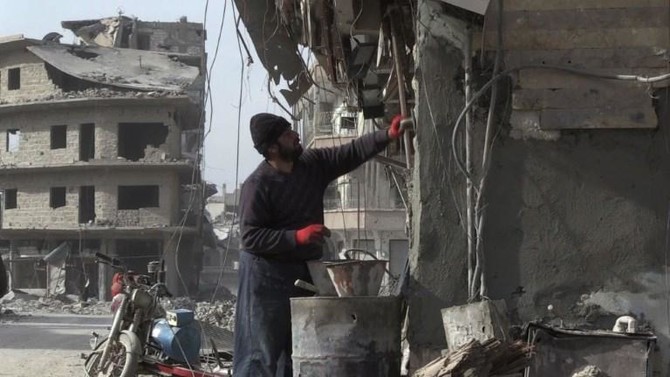RAQQA, Syria: Raqqa is still mostly a sinister ghost town of gutted buildings and rubble-strewn streets but there is one place teeming with activity in the Syrian city: Ammar Qassab’s falafel shop.
“We reopened almost two weeks ago,” the 33-year-old said, as one of his employees spooned balls of yellow chickpea mixture from a battered, bullet-pierced vat and dipped them in searing oil.
“King Falafel is famous here,” Qassab said, smiling as customers crowded his tiny shop in central Raqqa.
Only a few months ago, the northern Syrian city was still the inner sanctum of the Daesh’s now defunct “caliphate.”
A huge military operation, led on the ground by Kurdish fighters and in the air by US warplanes, defeated the extremists but also left the city completely disfigured.
Once home to around 300,000 people, Raqqa’s neighborhoods were empty when it was declared retaken in mid-October.
Three months on, despite the lack of infrastructure and the lingering threat of unexploded mines and bombs, a trickle of residents — a few hundred families — are attempting to return.
“I cannot say how happy it makes me to see people return to the city and come here again,” said Qassab.
He sells around 1,200 falafel sandwiches a day, a number he explained was the result of recent returnees not having working kitchens to prepare their own food.
King Falafel, across from the famed Harun Al-Rashid park, was itself a food landmark in Raqqa for more than four decades.
It stayed open even after extremists took over the city in 2014 but had to close a year ago as fighting to oust IS got closer.
For Qassab and other Raqqa natives, the reopening of the falafel shop signals a return to familiar things.
The owner and his helpers are back to dropping balls of mashed chickpeas into a deep frier, then pressing the crispy puck-shaped falafel into flatbread with pickles and tahini.
And like they once did years ago, customers pull up plastic chairs to the storefront to dig into their savoury sandwiches.
“I was 10 when I came here for the first time,” said Issa Ahmed Hassan, a white-haired man in his fifties.
“My family and I used to come for the park to watch the people walk by,” he said.
Hassan left Raqqa two years ago with the rest of the city’s Kurdish minority, and King Falafel was one of his first stops when he returned to his hometown.
“A lot of people didn’t come back because of this crisis. God willing, the situation will get better and Raqqa will be even more beautiful than before,” he said.
Across the city, life is attempting to take hold in neighborhoods that were restricted military areas just weeks ago.
Returnees seek out the few shops that have reopened to find basic goods, but many struggle to contain their anger at what they see is the slow pace of reconstruction.
“I came back to find my house a wreck, with rubble two meters high,” said Abdel Sattar Al-Abid, a 39-year-old who returned to rebuild his home in the devastated Old City.
Dozens of security forces and civilians have been killed and wounded since October by the explosion of booby-traps and roadside bombs left behind by Daesh.
Abid was critical of the local authorities, saying not enough was being done to bring back water and clean up the streets.
“I risked my life and started cleaning up without even checking for mines. We just started because we want to live here,” he said.
Across the city, residents have similar complaints.
With infrastructure still ravaged, they are relying on neighborhood electricity generators and water that has been trucked in.
Iman Al-Faraj, 40, returned to Raqqa almost three weeks ago to find nothing standing from her beloved home except a single room.
“Look at our houses. They’re all destroyed. Who has the money to rebuild?” the mother-of-eight cried out.
“From an entire house, I’ve got nothing except one room. I fixed it and put in a door, and now that’s where we live.”
“We pay 1,000 Syrian pounds (about $2) for a single ampere of electricity. We can’t live in darkness,” said Faraj.
Near the Old City’s ancient Rafiqah wall, Mohammad Omar has lined up rows of gas canisters and plastic jugs of diesel.
“If you have money, you buy diesel. If you don’t have money, you burn wood. If you don’t have wood, you burn sponge mattresses or furniture,” said Omar, 25.
And just a few meters away, Ismail Omar gazed at his ravaged home.
“We’re the biggest losers in this war. We’ve got nothing left but destruction, mines, hunger, and poverty,” the 45-year-old said.
“What’s gone isn’t coming back.”

























